Planning your first trip to Zion National Park? This beginner-friendly Zion National Park guide covers top things to do in Zion, hiking tips, and must-know advice!
Zion National Park holds a special place in my heart. I’ve had the chance to visit twice now, and each time, I’ve been blown away by its breathtaking red cliffs, winding canyons, and incredible hiking trails. It’s easily my favorite U.S. national park, and I’m excited to share why I think it should be at the top of your travel list too.
As a first-time visitor, planning your trip might feel overwhelming with so much to see and do. That’s why I’ve put together this guide—to help you navigate the park like a pro and make the most of your visit.
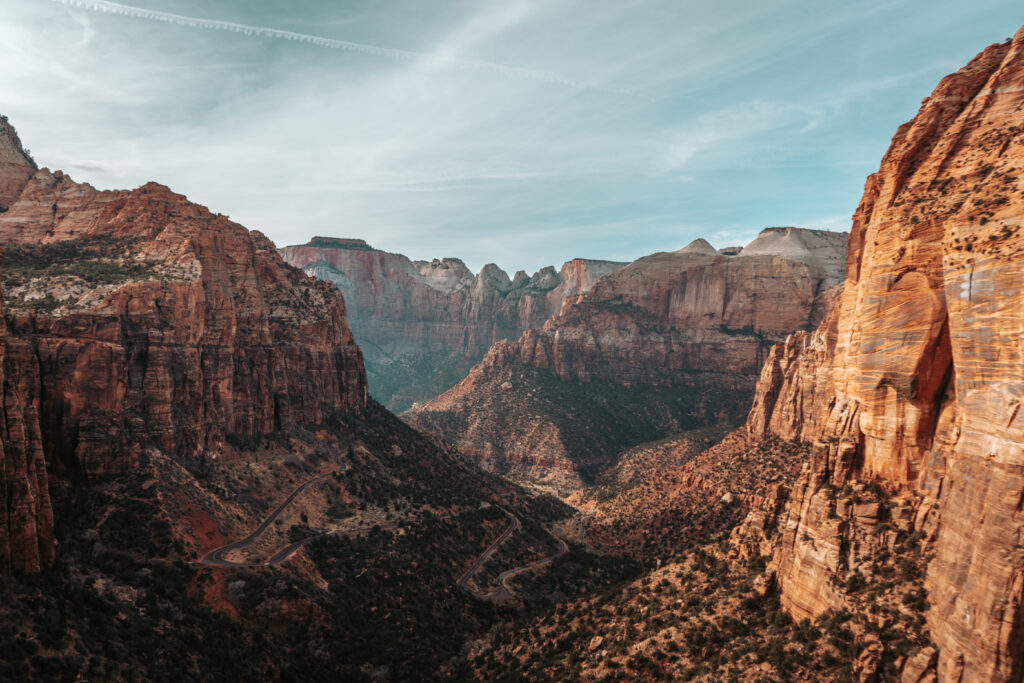
Zion National Park Guide for Beginners
Best Time to Visit Zion National Park
Zion National Park is stunning year-round, but the best time to visit really depends on what kind of experience you’re looking for. Many people visit during the spring and fall, thanks to mild temperatures and vibrant scenery. However, I visited in December, and it turned out to be an incredible time to explore Zion—especially for beginners.
Why December is a Great Time to Visit Zion:
- Fewer Crowds: One of the biggest perks of visiting in December is avoiding the peak-season crowds. Popular hikes like Angels Landing and The Narrows are far less busy, making it easier to fully enjoy the park’s natural beauty without feeling rushed.
- No Shuttle System: From mid-March through late November, Zion operates a mandatory shuttle system to reduce traffic. However, in December, you can drive your own vehicle into the canyon, offering more flexibility and convenience for first-time visitors.
- Mild Temperatures: While Zion can get extremely hot in summer, December temperatures are much more comfortable, often ranging from the mid-40s to low 60s °F (4–16°C). It’s cool enough for hiking without overheating, but not too cold to be uncomfortable.
My Experience Visiting in Summer: The first time I visited Zion was in July, and it was so hot that we didn’t end up doing any hikes. Temperatures often soar above 100°F (37.8°C), making it challenging to enjoy the park unless you start activities very early in the morning or stick to shaded areas. If you’re not a fan of extreme heat, summer may not be the best time for hiking in Zion.
Other Seasonal Considerations:
- Spring (March–May): Waterfalls are at their fullest, and wildflowers start to bloom. However, spring break crowds can make it busy.
- Summer (June–August): This is peak tourist season, but it’s also the hottest time of year. If you visit in summer, plan to start hikes early in the morning to avoid the heat.
- Fall (September–November): Cooler temperatures and colorful foliage make fall a popular choice. Crowds taper off slightly compared to summer.
- Winter (December–February): Quiet trails and serene landscapes make winter an underrated gem for Zion visitors. Just be prepared for occasional snow at higher elevations.
How to Get to Zion National Park
Zion National Park is located in southwestern Utah, making it accessible from several major cities and nearby attractions. Here’s how to get there:
From Las Vegas
(Approximately 2.5 Hours / 160 Miles or 257 km)
Most visitors fly into Harry Reid International Airport (LAS) in Las Vegas and then drive north on I-15. The route is straightforward, offering scenic desert views along the way. Once you reach Exit 16 near Hurricane, you’ll follow UT-9 East, which leads directly to the park’s entrance in Springdale.
From Salt Lake City
(Approximately 4.5 Hours / 311 Miles or 500 km)
Travelers who fly into Salt Lake City International Airport (SLC) and head south on I-15. After passing Cedar City, take Exit 27 toward Toquerville and connect with UT-9 East into Springdale. This route highlights Utah’s diverse landscapes, transitioning from urban surroundings to dramatic red rock scenery.
From Grand Canyon
(Approximately 4 Hours / 210 Miles or 338 km)
If you’re starting at the Grand Canyon North Rim, head north on AZ-67 and connect to US-89 toward Kanab, Utah. From there, follow US-89 to Mount Carmel Junction and take UT-9 West directly into Zion. Travelers coming from the South Rim will need to follow US-89 for a longer stretch, enjoying breathtaking vistas along the way.
No matter where you’re coming from, the journey to Zion is part of the adventure. Each route provides incredible landscapes, making your road trip as memorable as the park itself!
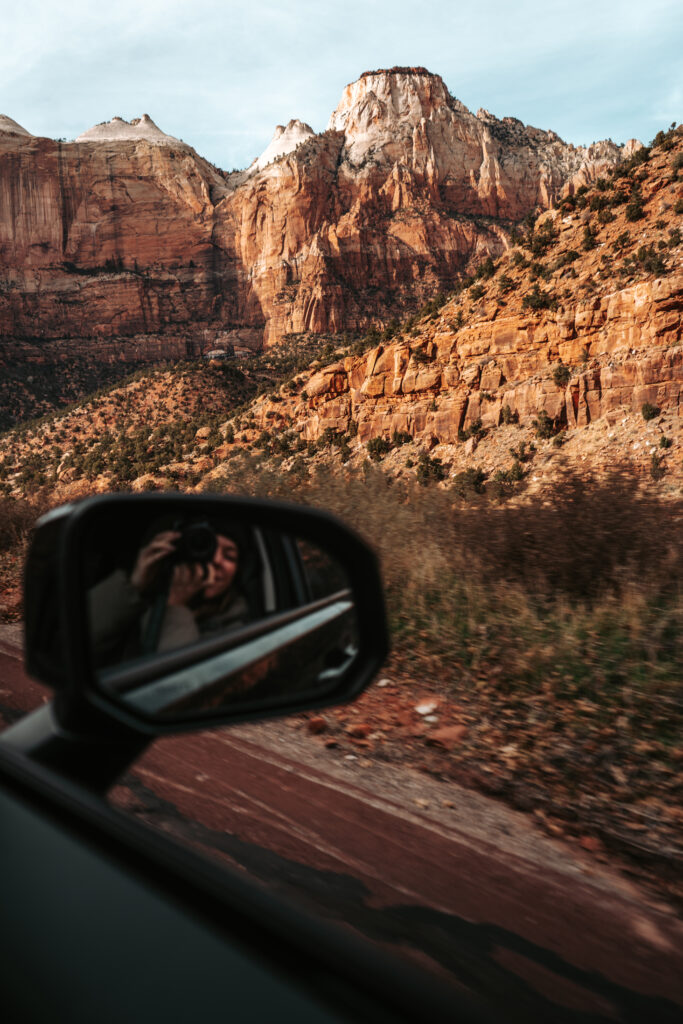
Zion National Park Guide: Where to Stay Near Zion National Park
During my visit, I stayed at Zion White Bison Resort, and it was an unforgettable experience. The resort offers a unique blend of comfort and cultural appreciation, with accommodations that include cliff dwellings, wagons, and teepees. I stayed in a cliff dwelling, which was both cozy and beautifully designed to honor traditional Indigenous customs in the area. Each cliff dwelling features a full kitchen, a private rooftop with a BBQ, and a private hot tub with gorgeous views of the mountains—perfect for relaxing after a day of hiking.
Zion White Bison Resort is conveniently located just 20 minutes from Zion National Park, making it an ideal base for your adventures. During peak seasons, the resort offers a shuttle service directly to the park, allowing you to leave your vehicle behind and avoid parking hassles.
Read More // Want to stay at Zion White Resort? Read my full blog post on my own stay and why this is the best place to stay near Zion.


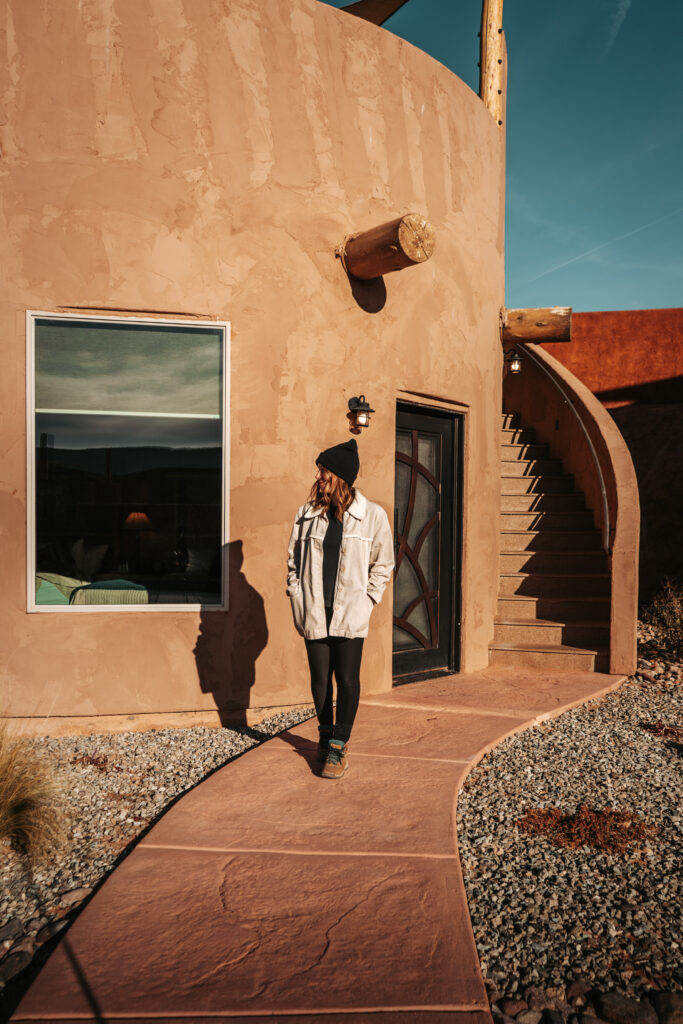
One of the highlights of Zion White Bison Resort is the presence of four white bison on-site. White bison are extremely rare, with estimates suggesting only one in 10 million bison are born white. They hold deep spiritual significance in many Indigenous cultures, symbolizing purity, abundance, and renewal. For centuries, white bison have been revered as sacred animals, and their appearance is often considered a sign of hope and unity.
The opportunity to see these majestic creatures up close added a profound sense of connection to nature and history during my stay. The resort is committed to preserving and celebrating Indigenous traditions, making it more than just a place to sleep—it’s an experience rich in culture and meaning.
Whether you’re looking for a unique place to stay or hoping to experience something meaningful during your trip, Zion White Bison Resort is a fantastic option that combines comfort, history, and a touch of wonder.
The Details
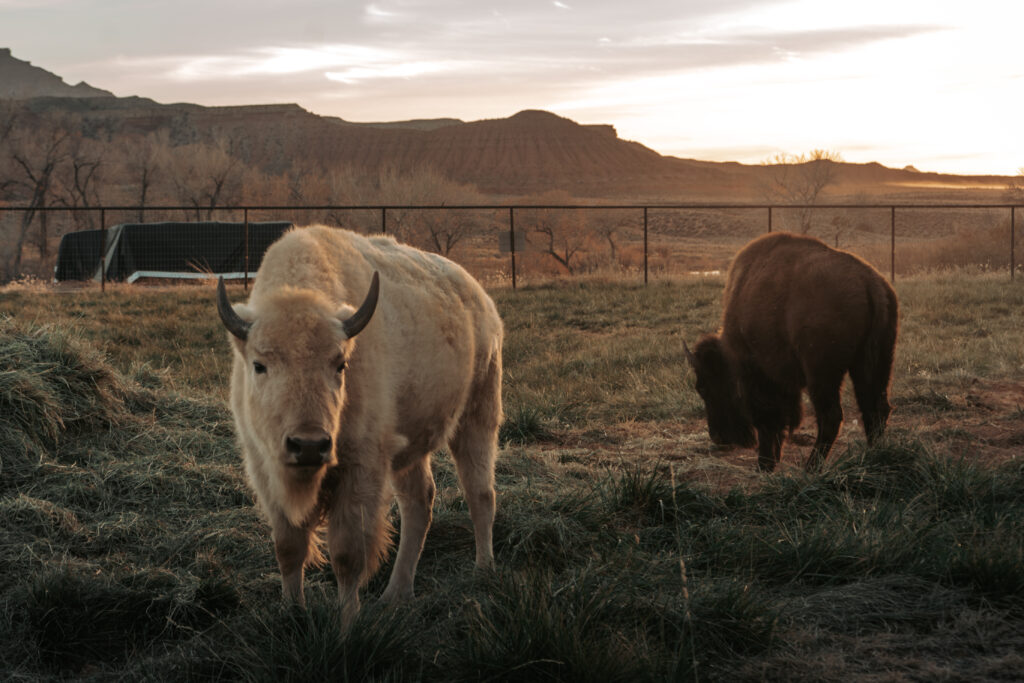
Top Things to Do in Zion : Your Zion National Park Guide
Must-Do Hikes for Beginners
Zion National Park offers a variety of beginner-friendly hikes that showcase its stunning landscapes without requiring advanced skills. Here are some must-do hikes for beginners:
Pa’rus Trail
Distance: 3.5 mile (5.6km) round trip
Length of Time: 1 hour
Difficulty: Easy
Zion Shuttle Stop: Visitor Center
The Pa’rus Trail is a 3.5-mile (5.6 km) out-and-back paved path that offers an accessible and scenic experience for visitors of all ages and abilities. Starting near the Zion Canyon Visitor Center, the trail meanders alongside the Virgin River, providing stunning views of the surrounding red rock formations and the Watchman mountain. Its gentle terrain makes it ideal for walking, biking, and is the only trail in the park where pets are permitted on a leash.
Good to know // The Pa’rus Trail is also wheelchair accessible, ensuring that everyone can enjoy the natural beauty of Zion. This trail is also the only one in the park that is dog friendly.
Along the way, multiple bridges cross the river, and there are several spots to access the water, making it a pleasant route for a leisurely stroll or a family outing. The trail’s name, “Pa’rus,” is derived from a Paiute word meaning “bubbling water,” reflecting the serene ambiance of the Virgin River that accompanies you throughout the hike.
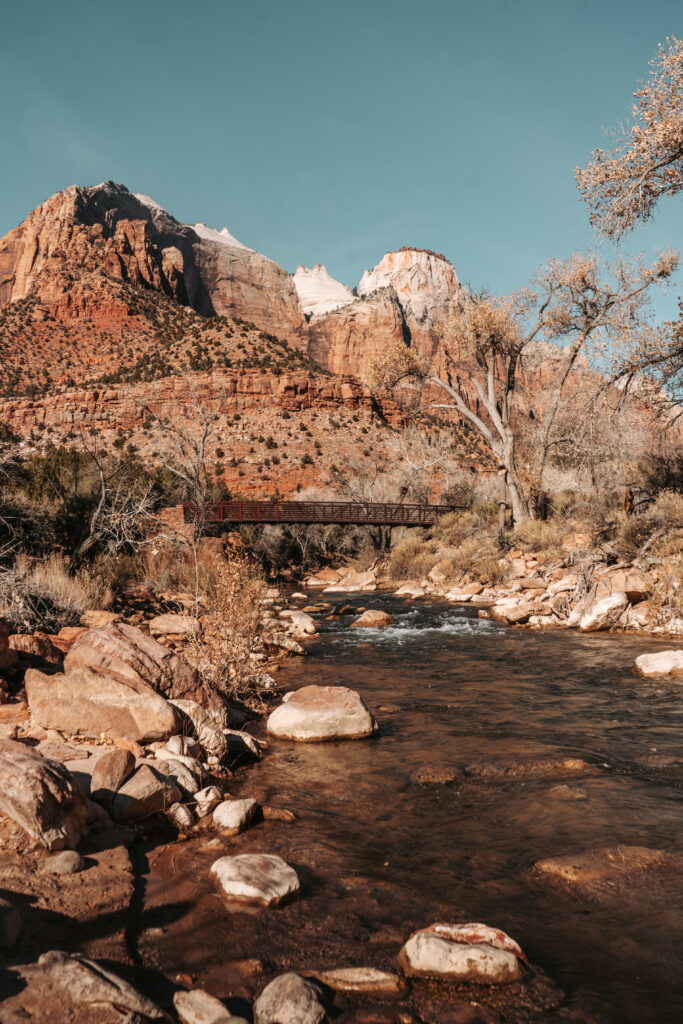
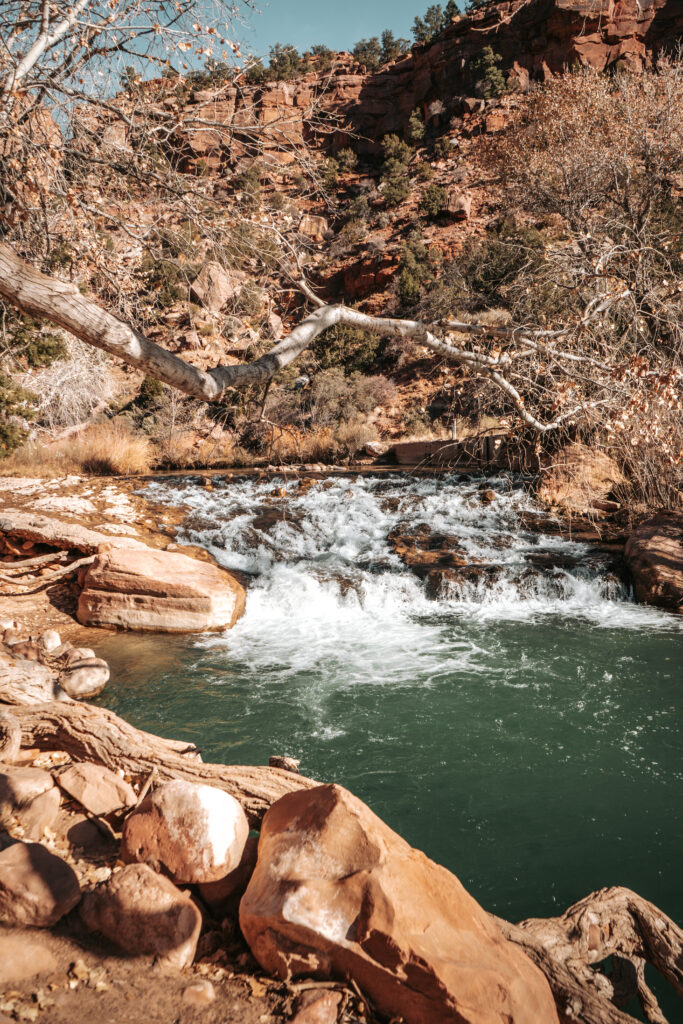
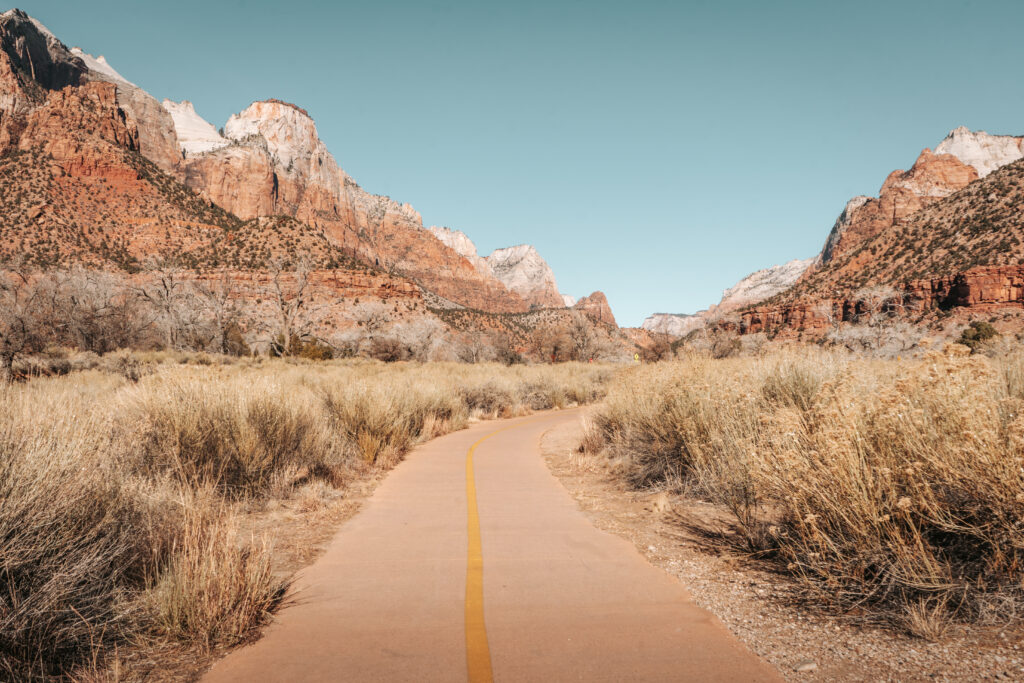
Emerald Pools Trail
Distance: 1.5 to 3 miles (2.4 to 4.8km), depending on how far you hike
Length of time: 2 to 3 hours
Difficulty: easy to moderate
Zion Shuttle Stop: The Grotto
The Emerald Pools Trail is a popular hiking destination that leads visitors to a series of natural pools and waterfalls.
Hiker’s tip // Traditionally, the trail begins at the Zion Lodge, crossing a bridge over the Virgin River to access the Lower, Middle, and Upper Emerald Pools. However, as of December 2024, the bridge near Zion Lodge is closed due to safety concerns, making the traditional route inaccessible. To reach the Lower Emerald Pool, hikers can now take the Kayenta Trail from The Grotto (Shuttle Stop #6). This alternative route adds approximately 1.5 miles (2.4 km) to the hike and introduces a moderate elevation gain, making the journey slightly more strenuous. Despite the increased effort, the Kayenta Trail offers stunning views of Zion’s rugged landscapes and the Virgin River, enhancing the overall hiking experience.
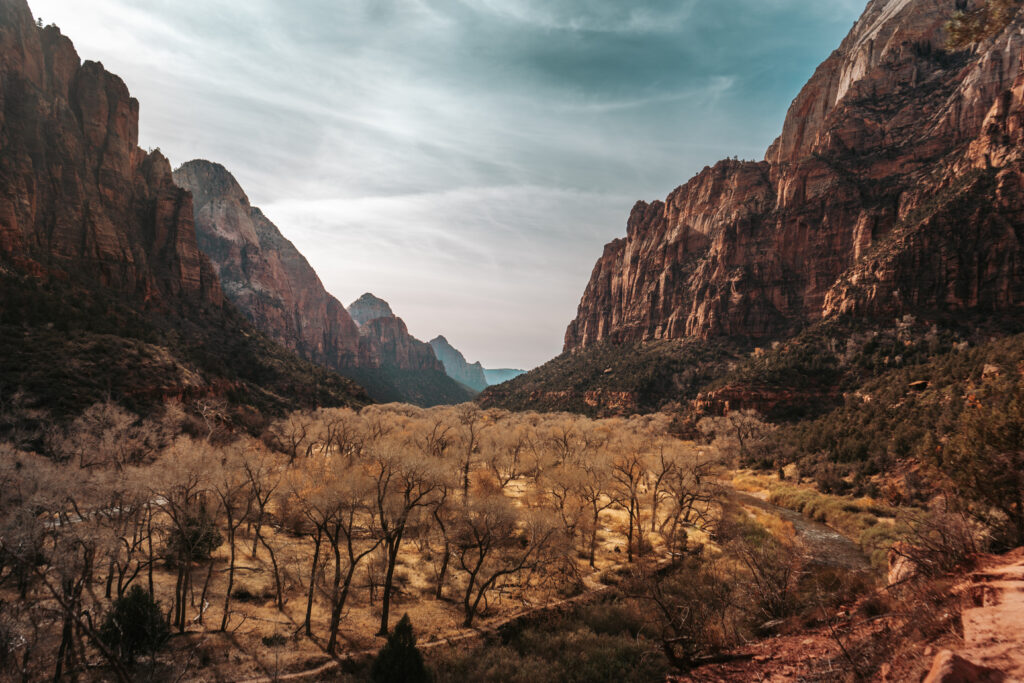
Upon arrival, the Lower Emerald Pool captivates with its serene waters and ephemeral waterfalls, offering a tranquil oasis amidst the park’s grandeur. For those seeking further adventure, the trail continues to the Middle and Upper Emerald Pools. While the views along the way are undeniably gorgeous, especially with the surrounding canyon walls and vistas, the pools themselves may not be particularly impressive during December, as water levels can be low and the waterfalls may be reduced to a trickle.
Hiker’s tips // Hikers should be prepared for winter conditions, as temperatures can range from 30°F to 60°F (-1°C to 16°C) during the day, with potential ice and snow hazards. It’s advisable to wear appropriate winter clothing and use traction devices like Yaktrax for icy sections.
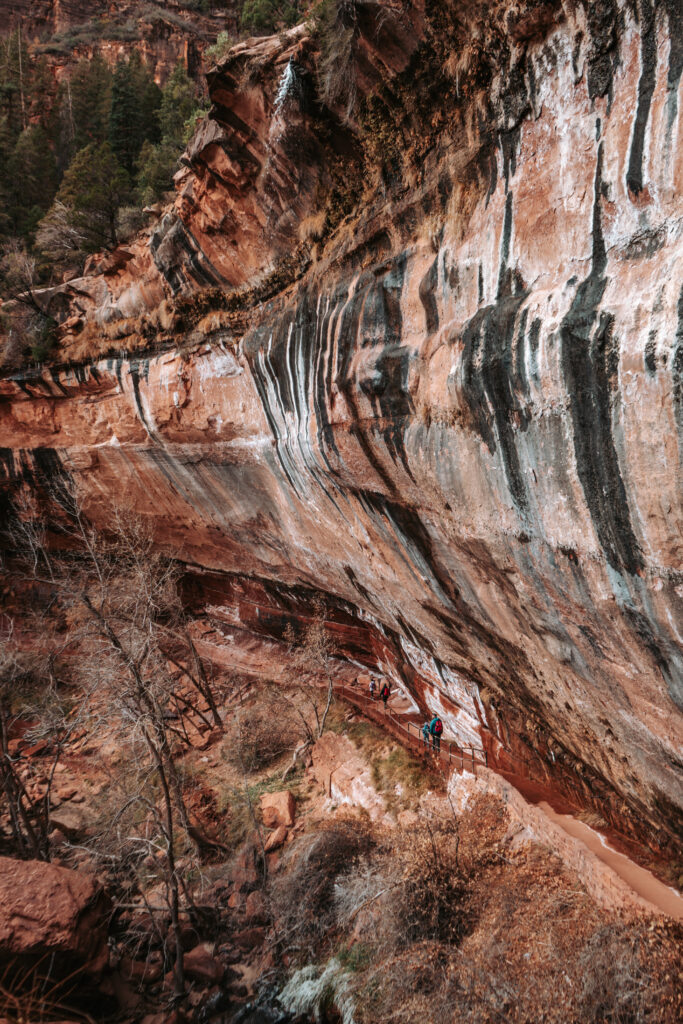
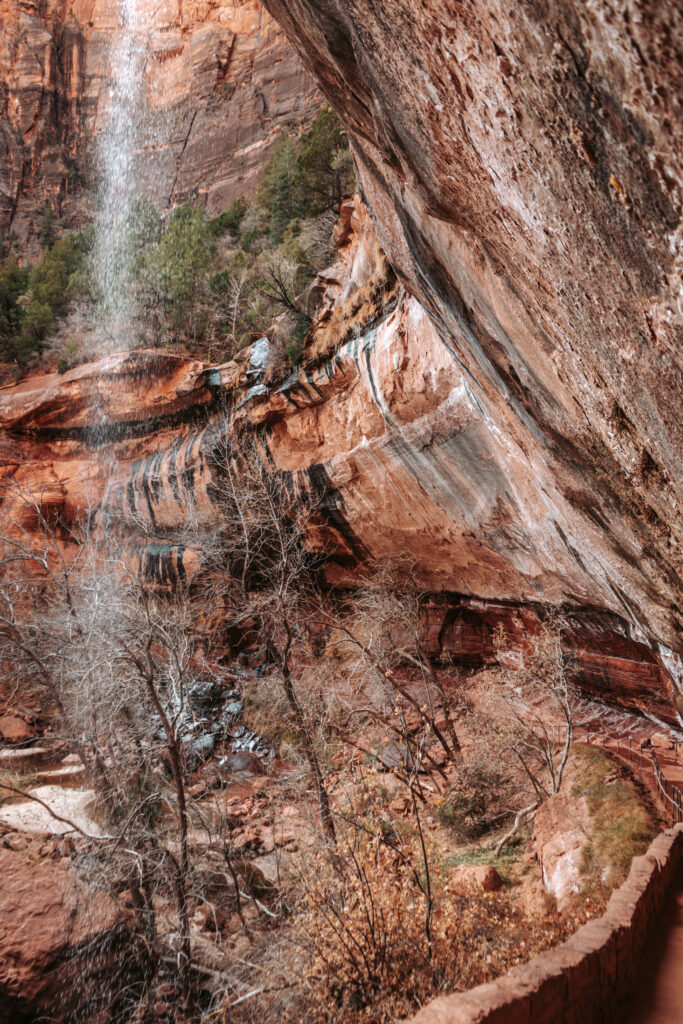
Riverside Walk Trail
Distance: 2.2 miles (3.5km) round trip
Length of Time: 1.5 hours
Difficulty: Easy
Zion Shuttle Stop: Temple of Sinawava
The Riverside Walk is a 2.2-mile (3.5 km) round-trip, paved trail that offers an easy and accessible hiking experience for visitors of all ages and abilities.
Beginning at the Temple of Sinawava, the trail meanders alongside the Virgin River, providing hikers with stunning views of towering sandstone cliffs and lush hanging gardens. As you stroll along this mostly flat path, you’ll be immersed in the serene beauty of the canyon, with opportunities to spot local wildlife and enjoy the soothing sounds of the river.
Hiker’s tips // The Riverside Walk is also known as the “Gateway to the Narrows,” as it leads to the starting point of the famous Narrows hike.
This trail is perfect for families, casual walkers, and anyone seeking to experience the natural splendor of Zion without undertaking a strenuous hike.
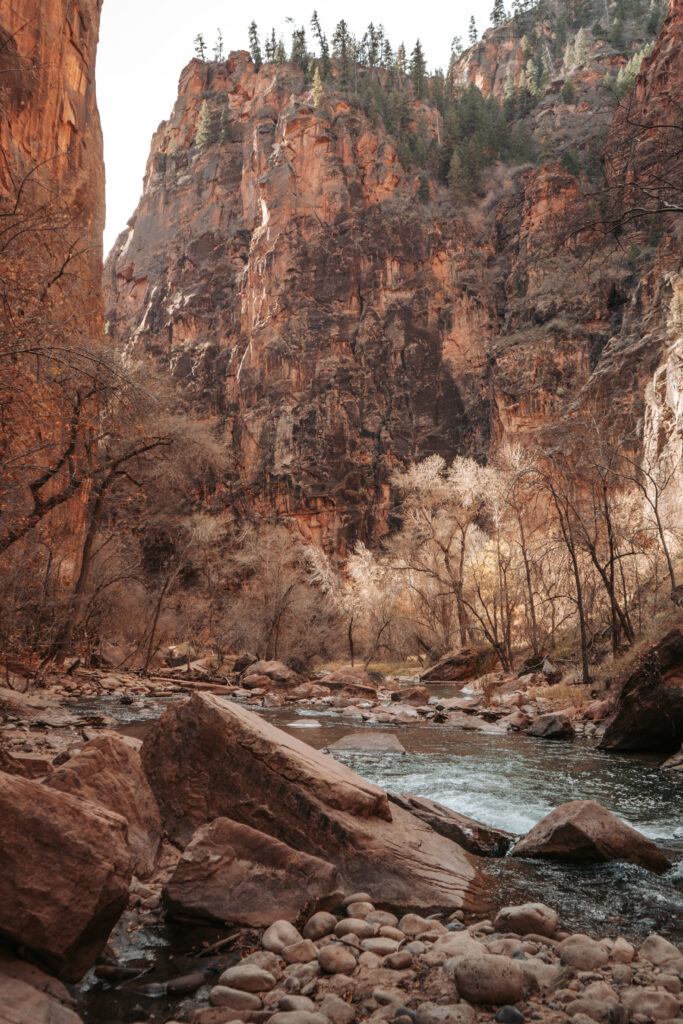
Thimber Creek Overlook Trail
Distance: 1 miles (1.6km) round trip
Length of Time: 30 minutes
Difficulty: Easy
Trailhead: Kolob Canyon
The Timber Creek Overlook Trail is a short, relatively easy hike located in the Kolob Canyons section of Zion National Park. The trail is approximately 1 mile (1.6 kilometers) round-trip, with minimal elevation gain, making it suitable for most visitors.
Hiking this trail rewards you with panoramic views of the Kolob Canyons, Kolob Terrace, and the Pine Valley Mountains. On clear days, you might even glimpse Mount Trumbull, about 100 miles away at the north rim of the Grand Canyon.
The trailhead is located at the end of Kolob Canyons Road, which is about a 1-hour drive from Zion Canyon. This makes it a convenient detour if you’re traveling between Zion and Bryce Canyon National Parks. However, if your time in Zion is limited, you might prefer to focus on the main canyon’s attractions, as they offer a broader range of experiences. For those with extra time or seeking a quieter experience away from the main canyon’s crowds, the Timber Creek Overlook Trail provides a serene hike with rewarding vistas. It’s especially beautiful during the spring and early summer months when wildflowers are in bloom.
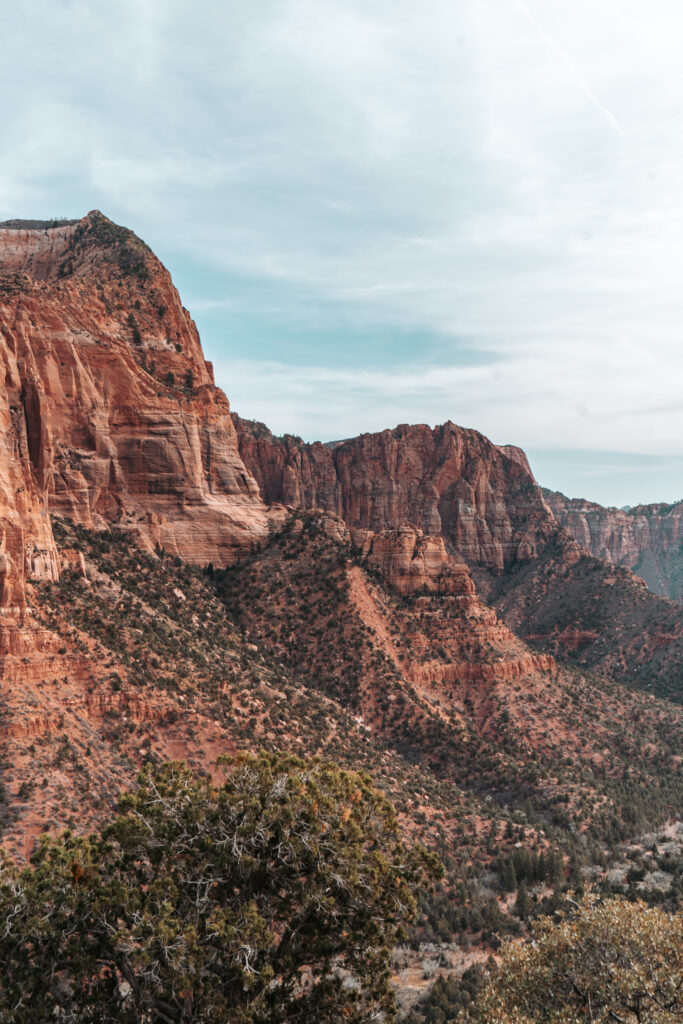
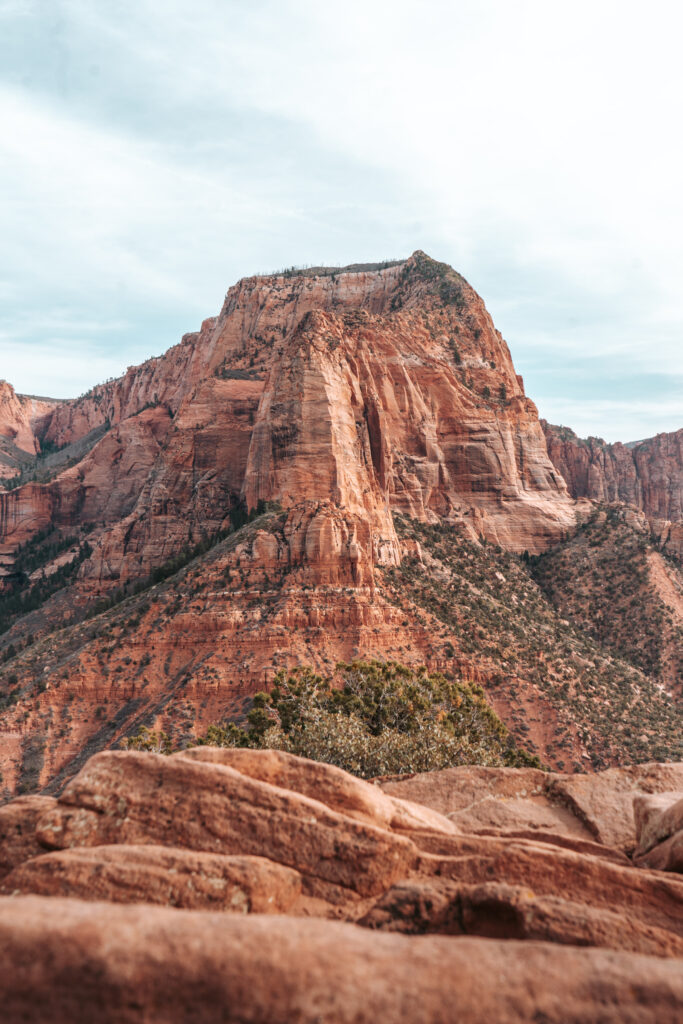
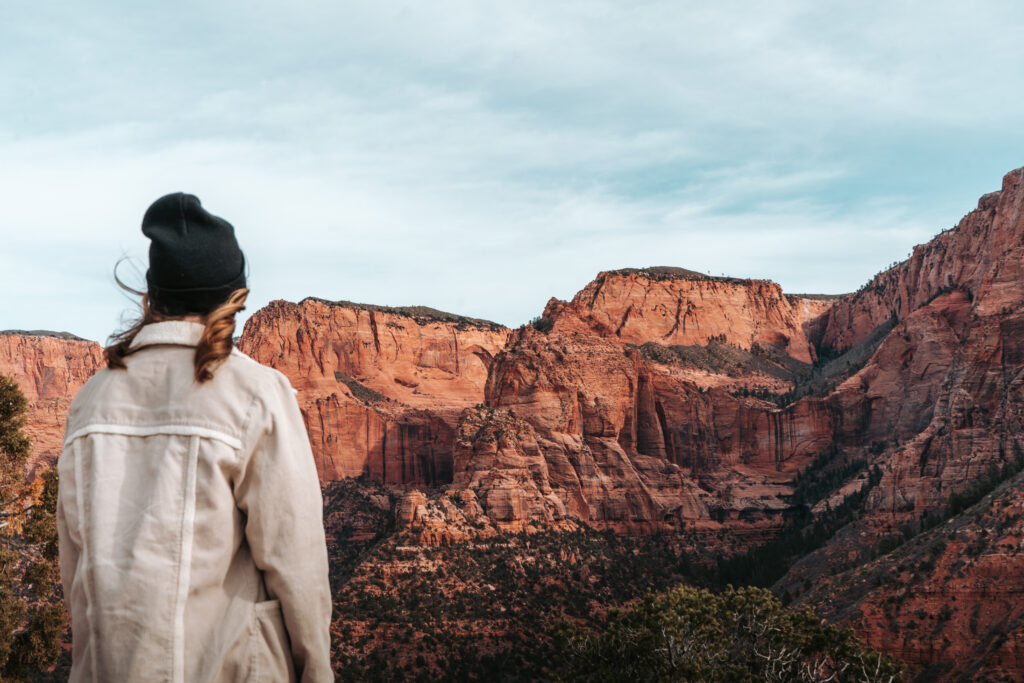
Canyon Trail Overlook
Distance: 1 mile (1.6km) round-trip
Length of Time: 1 hour
Difficulty: easy to moderate
Trailhead: Highway 9, just east of the Mount Carmel Tunnel
The Canyon Overlook Trail is a 1-mile (1.6 km) round-trip hike that offers some of the most breathtaking views in the park.
Despite its relatively short length, the trail presents moderate challenges, including uneven terrain and several steep drop-offs, some of which are protected by guardrails (some of which are not!). These factors may make the hike less suitable for individuals with a fear of heights.
Hiker’s tips // While the Canyon Overlook Trail is often categorized among Zion’s easier hikes due to its length, it’s important for hikers to exercise caution and be prepared for its exposed sections. Those who undertake the trail are rewarded with stunning vistas, making it a worthwhile endeavor for many visitors.
The trailhead is located just east of the Zion-Mount Carmel Tunnel on Highway 9. As you exit the tunnel, the parking area is immediately on the right; however, it’s small and often full. If you miss it, you’ll need to find alternative parking further up the road, which can add distance to your hike. Arriving early in the morning or later in the evening increases your chances of securing a spot.
Please note, there is no shuttle service to this trailhead; access is only via private vehicle.
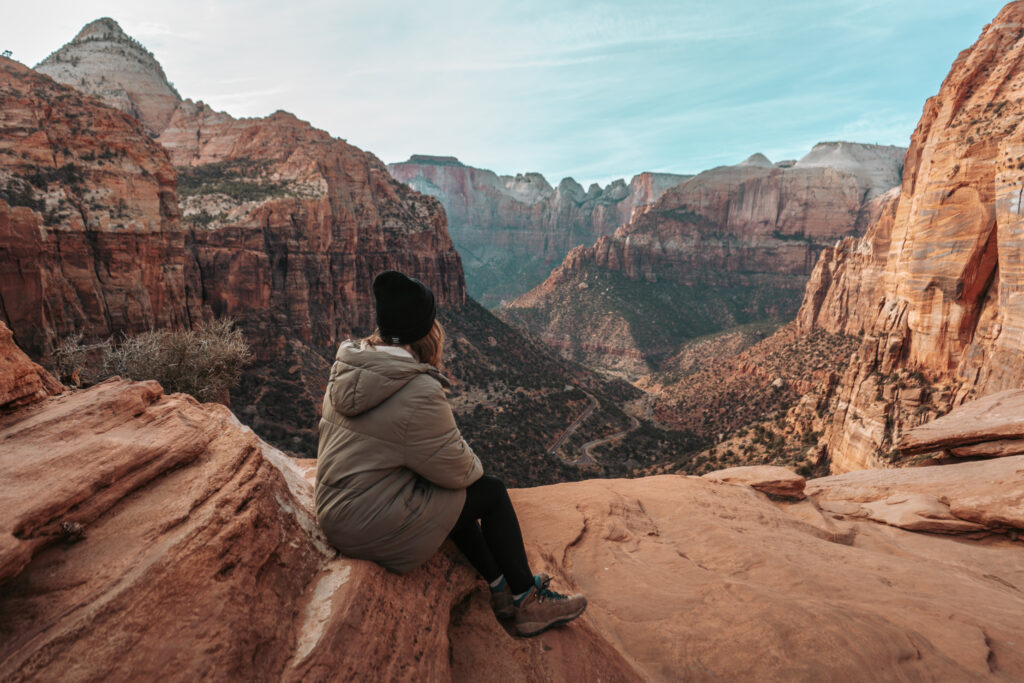
Moderate hikes that are definitely worth the effort
If you are looking for a bit of challenge with incredibly rewarding views, then you need to consider these trails:
Watchman Trail
Distance: 3.3 miles (5.3km) roundtrip
Length of Time: 2 hours
Difficulty: moderate
The Watchman Trail is a 3.3-mile (5.3 km) round-trip hike that ascends approximately 456 feet (139 meters), offering hikers panoramic views of Zion Canyon and the iconic Watchman Peak.
Despite its moderate difficulty, this trail is often overlooked in favor of more popular hikes, yet it stands out as a hidden gem within the park. The trail’s switchbacks provide an enjoyable ascent, leading to a breathtaking lookout at the summit. For those seeking a less crowded path with rewarding vistas, the Watchman Trail is a must-do experience.
Hiker’s tips // The trailhead is conveniently located near the Zion Canyon Visitor Center, eliminating the need for shuttle access.
The hike begins with a flat section along the Virgin River before ascending through a series of switchbacks that offer ever-expanding views of the canyon. At the summit, hikers are rewarded with a loop that provides diverse perspectives of the surrounding landscape, including views of Springdale, the Visitor Center, and prominent peaks such as The Temples.
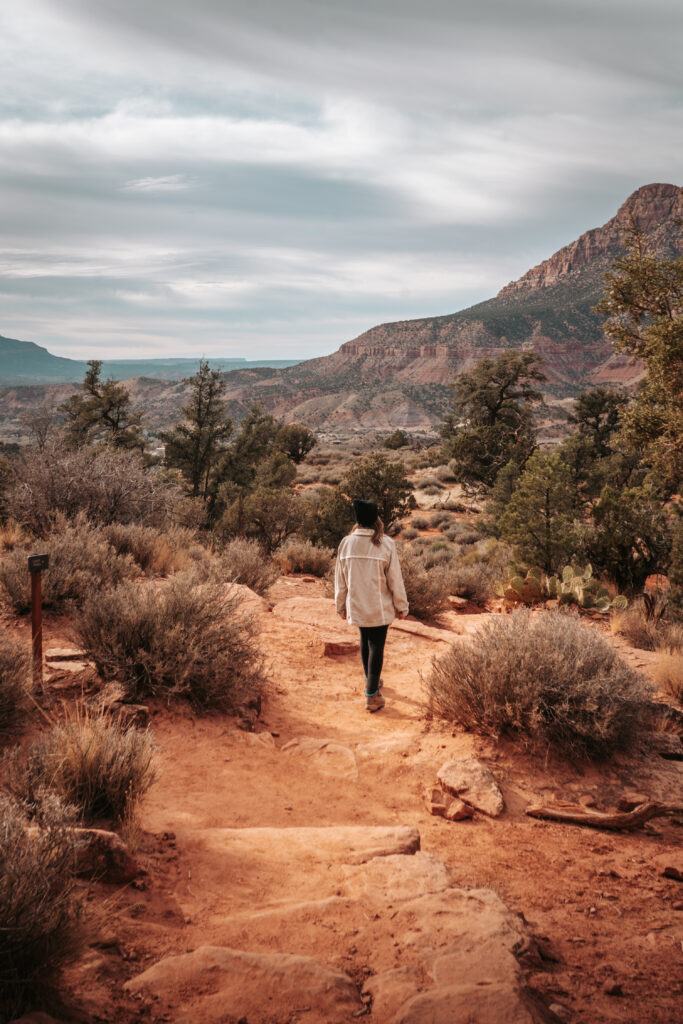
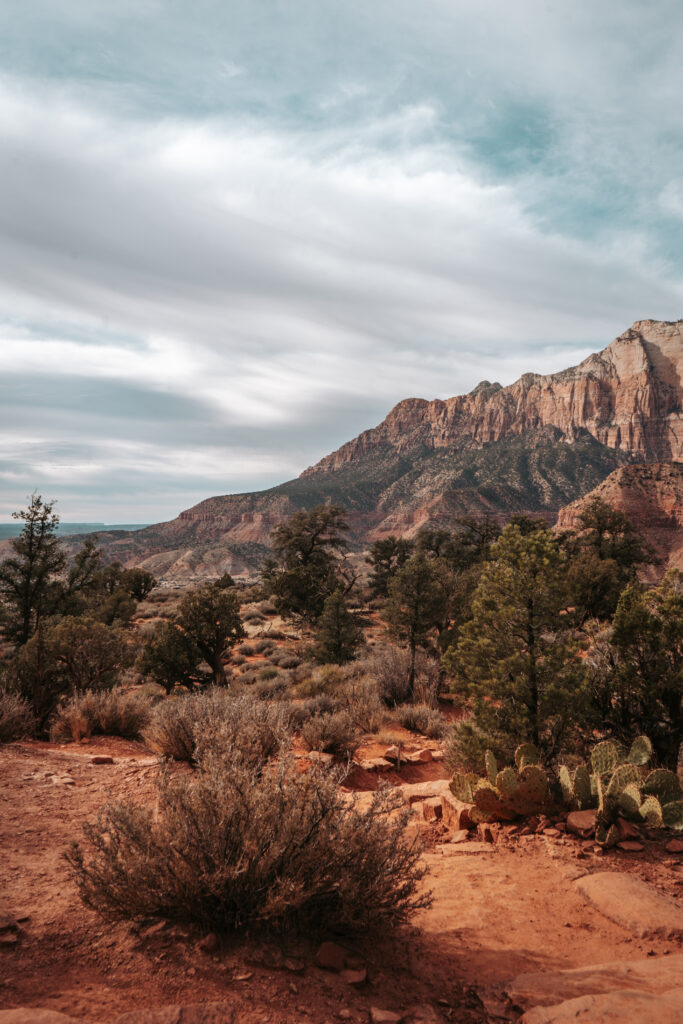
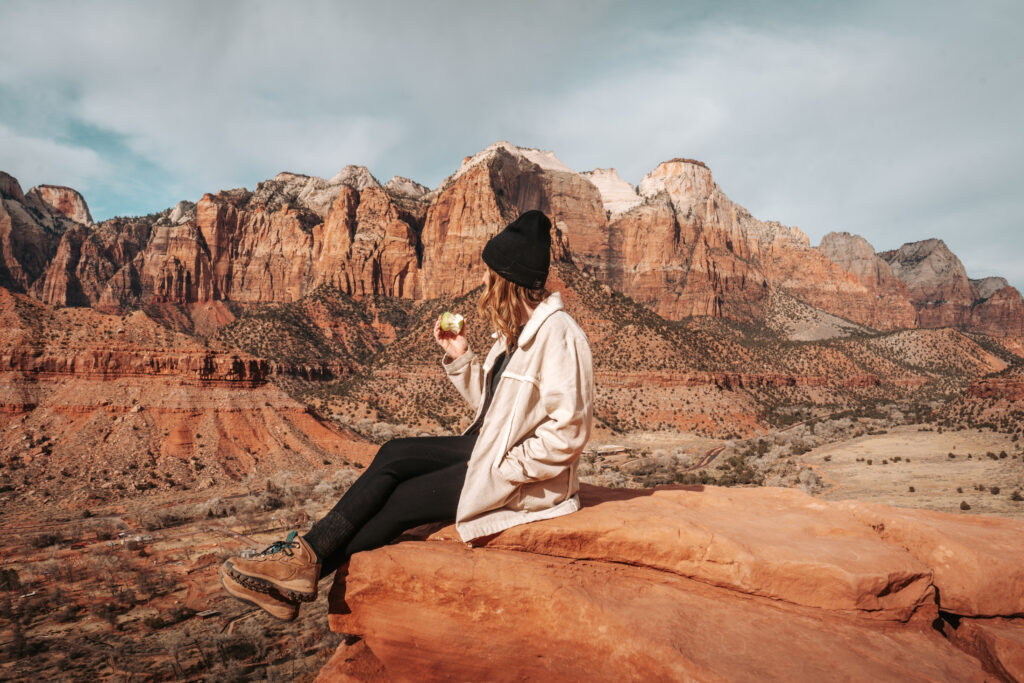
Scout Lookout Trail
Distance: 3,6 miles (5.8km), depending on how far you hike
Length of time: 3 – 4 hours
Difficulty: moderate to hard
Zion Shuttle Stop: The Grotto
The Scout Lookout Trail is a moderately challenging hike, approximately 3.6 miles (5.8 km) round-trip, with an elevation gain of about 1,000 feet (305 meters). The trail begins at The Grotto Trailhead and ascends through a series of steep switchbacks, including the renowned “Walter’s Wiggles,” a set of 21 tight switchbacks that test hikers’ endurance.
Upon reaching Scout Lookout, hikers are rewarded with expansive views of Zion Canyon and a close-up perspective of the Angels Landing ridge. While a permit is required to proceed beyond Scout Lookout to the summit of Angels Landing, reaching Scout Lookout itself does not require a permit.
This makes it an excellent option for those who, like me, may find the final ascent to Angels Landing daunting but still wish to experience the stunning vistas the area offers.
It’s important to note that the trail is entirely uphill and features numerous switchbacks, which can be strenuous. During my hike, I observed people of varying fitness levels successfully navigating the trail, which is why I categorize it as moderate rather than difficult. However, it’s crucial to ensure you carry sufficient water and allocate ample time to complete the hike safely.
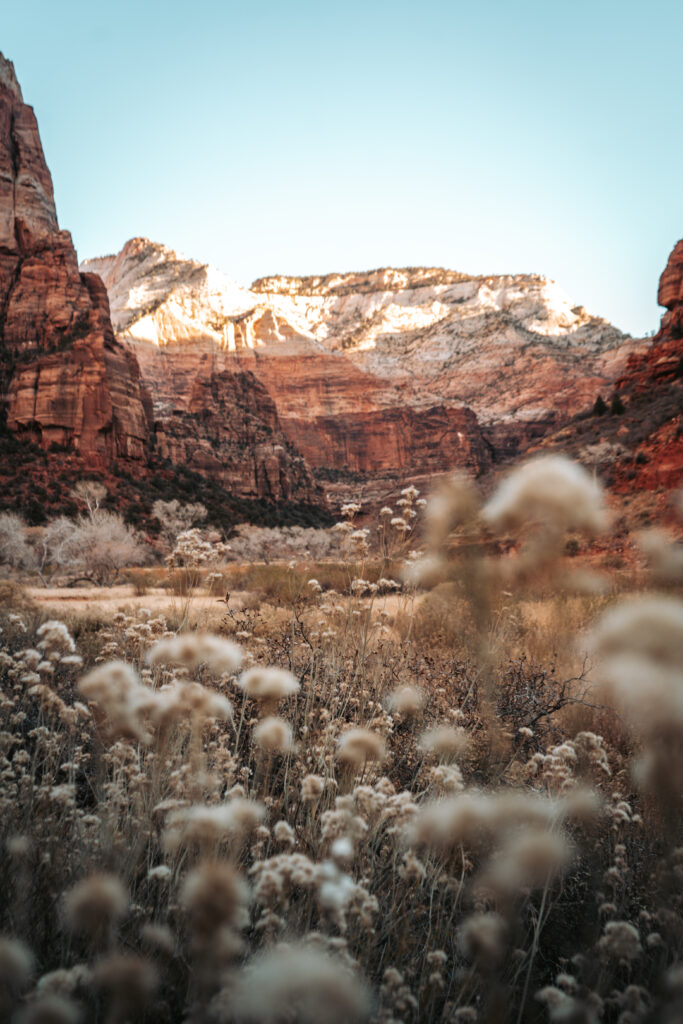
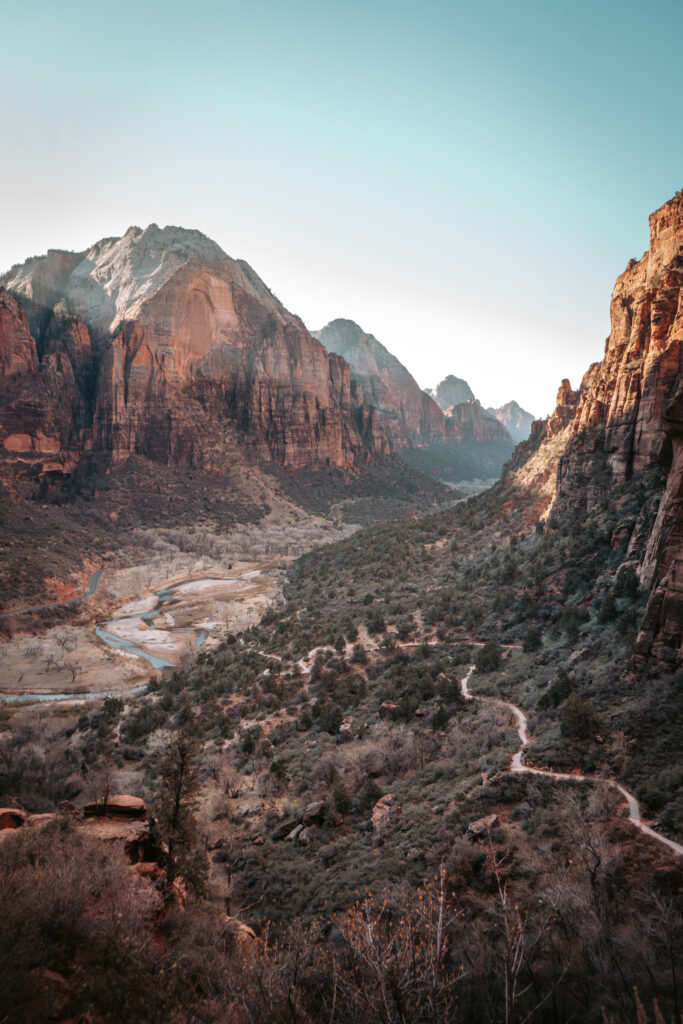
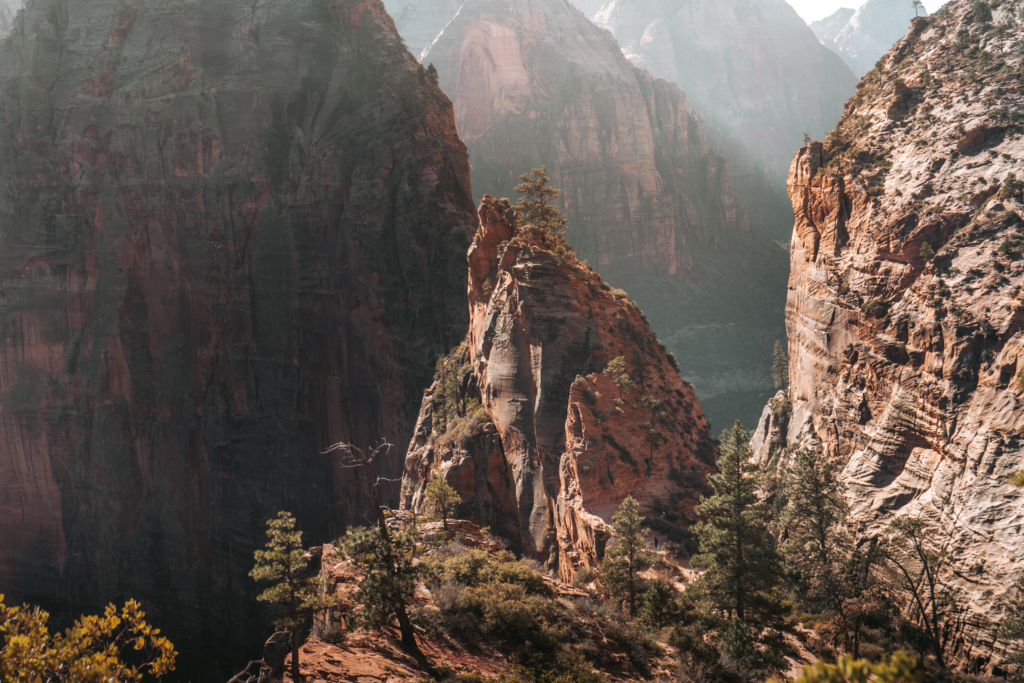
Scenic Drives and Viewpoints
Zion Canyon Scenic Drive
The Zion Canyon Scenic Drive is a picturesque route that winds along the floor of Zion National Park’s main canyon, closely following the Virgin River. Spanning approximately 6.5 miles (10.5 kilometers) one-way, the drive offers visitors intimate views of towering sandstone cliffs, lush vegetation, and access to several of the park’s most renowned trailheads and viewpoints.
During the peak season, typically from March through October, private vehicles are restricted from accessing this road to reduce traffic congestion and protect the park’s natural resources. Instead, visitors utilize the efficient Zion Canyon Shuttle System, which operates frequently and provides convenient access to various points of interest along the drive.
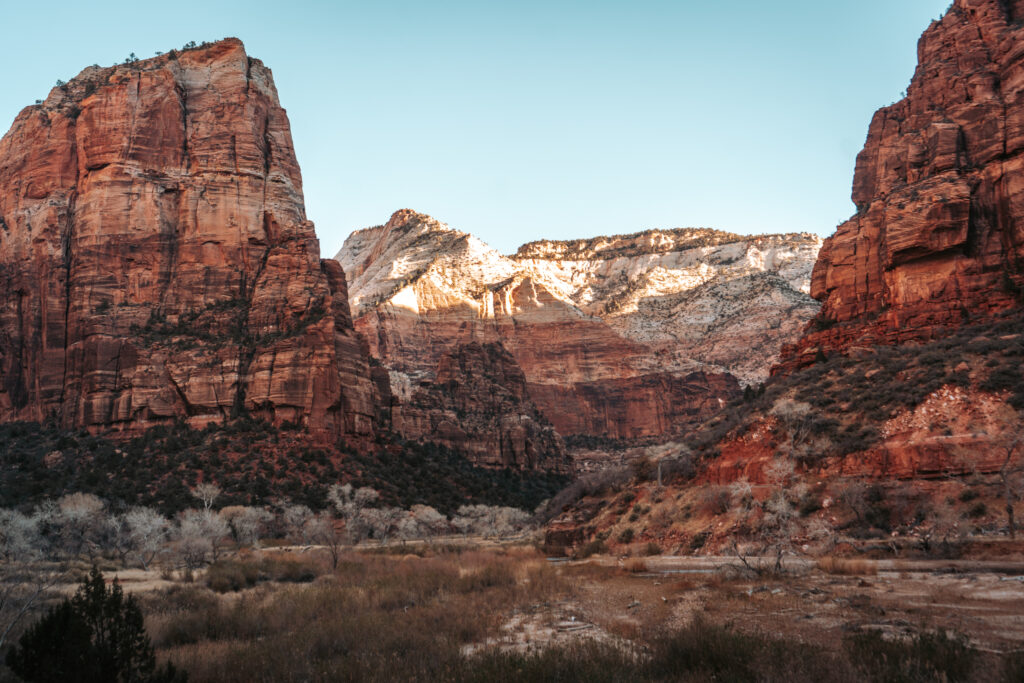
Court of the Patriarchs
The Court of the Patriarchs is a viewpoint that offers visitors a chance to see three prominent sandstone peaks named after biblical figures: Abraham, Isaac, and Jacob.
Hiker’s tips // The trail to the viewpoint is very short but steep, ascending approximately 40 feet (12 meters) over a distance of about 300 to 400 feet (90 to 120 meters).
Despite its brevity, the trail rewards hikers with panoramic views of the surrounding mountains and canyon walls, making it a worthwhile stop for those seeking a quick yet rewarding experience in the park.
The viewpoint is easily accessible from the park’s shuttle system (stop of the same name), making it convenient for visitors of all ages and abilities.
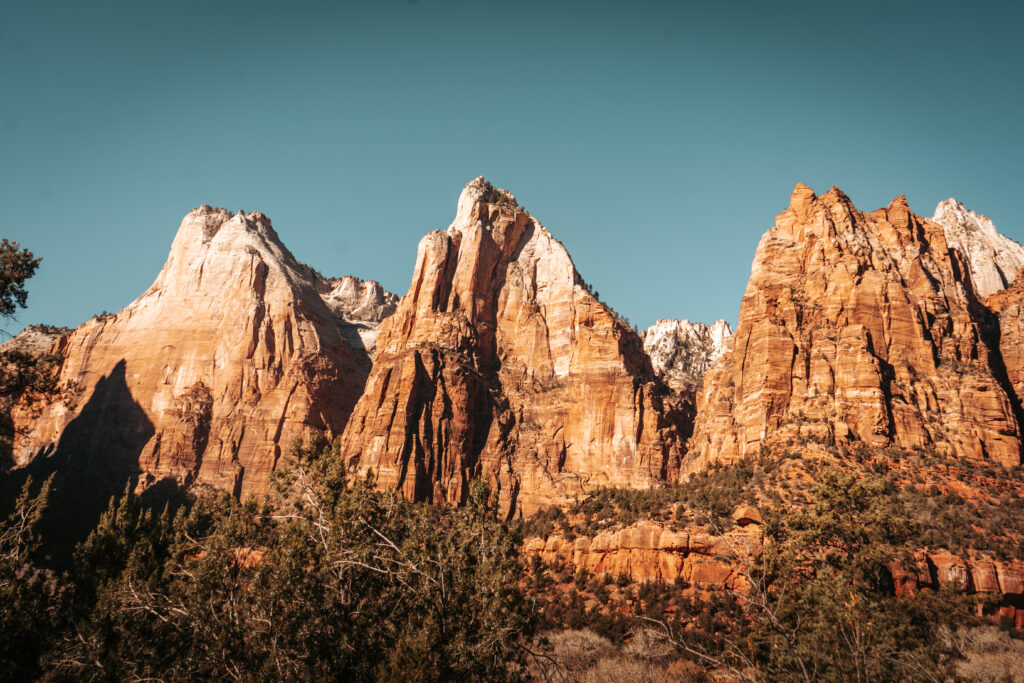
Zion-Mount Carmel Highway
The Zion-Mount Carmel Highway, part of Utah State Route 9, stretches approximately 25 miles (40 kilometers), with about 15 miles traversing Zion National Park.
This scenic drive connects the park’s South and East Entrances, offering travelers a journey through diverse landscapes, including towering sandstone cliffs, intricate rock formations, and expansive vistas. A highlight of the route is the historic Zion-Mount Carmel Tunnel, a 1.1-mile (1.8-kilometer) engineering marvel completed in 1930, which allows passage through the massive sandstone cliffs.
Driver’s tips // It’s important to note that the tunnel has size restrictions; vehicles over 11.33 feet (3.45 meters) in height or 7.83 feet (2.39 meters) in width require an escort, and larger vehicles may be prohibited.
Driving this highway provides access to several notable viewpoints and trailheads, making it a must-do for visitors seeking to experience the park’s natural beauty from the comfort of their vehicle.
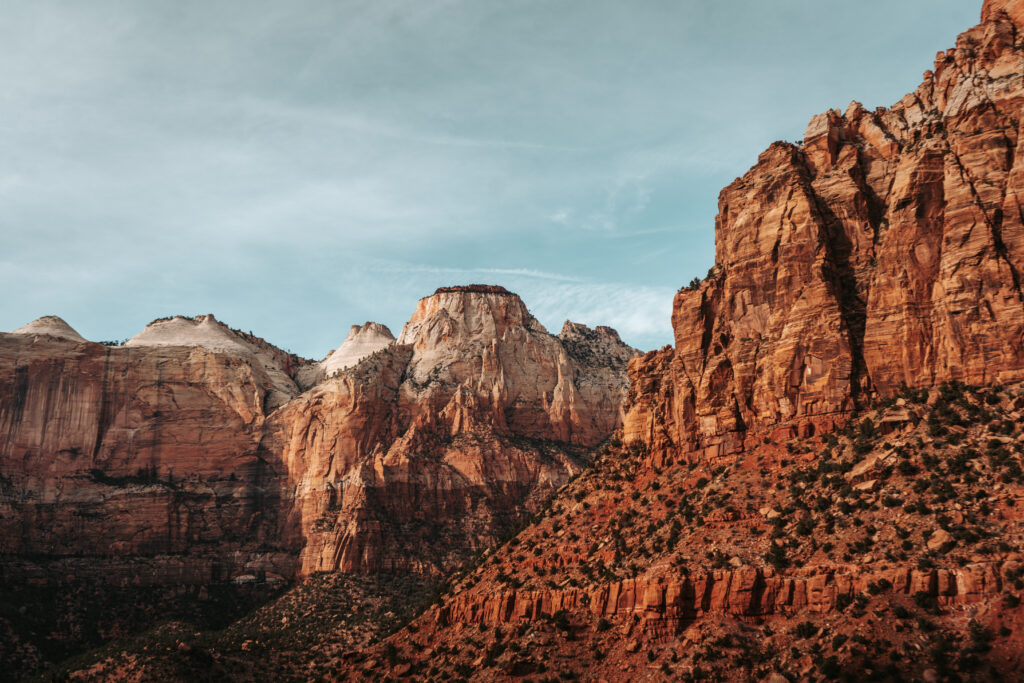
Kolob Canyons Road
The Kolob Canyons Road is a 5-mile (8-kilometer) scenic drive located in the northwestern section of Zion National Park. This area is approximately 40 miles (64 kilometers) north of Zion Canyon, translating to about a one-hour drive via Interstate 15.
For travelers en route to Bryce Canyon National Park, Kolob Canyons can is convenient detour, offering a chance to explore a less-visited section of Zion.
Driver’s tips // The Kolob Canyons district is located at Exit 40 on Interstate 15, 17 miles south of Cedar City.
However, if your time in Zion is limited, focusing on the main canyon’s attractions might be more rewarding. The primary Zion Canyon area offers a concentration of the park’s most iconic landscapes and trails, providing a comprehensive experience within a shorter timeframe. While Kolob Canyons offers a serene and scenic experience, it’s best suited for visitors with ample time or those passing through en route to other destinations like Bryce Canyon. For those on a tight schedule, dedicating time to Zion Canyon’s main attractions may provide a more fulfilling visit.
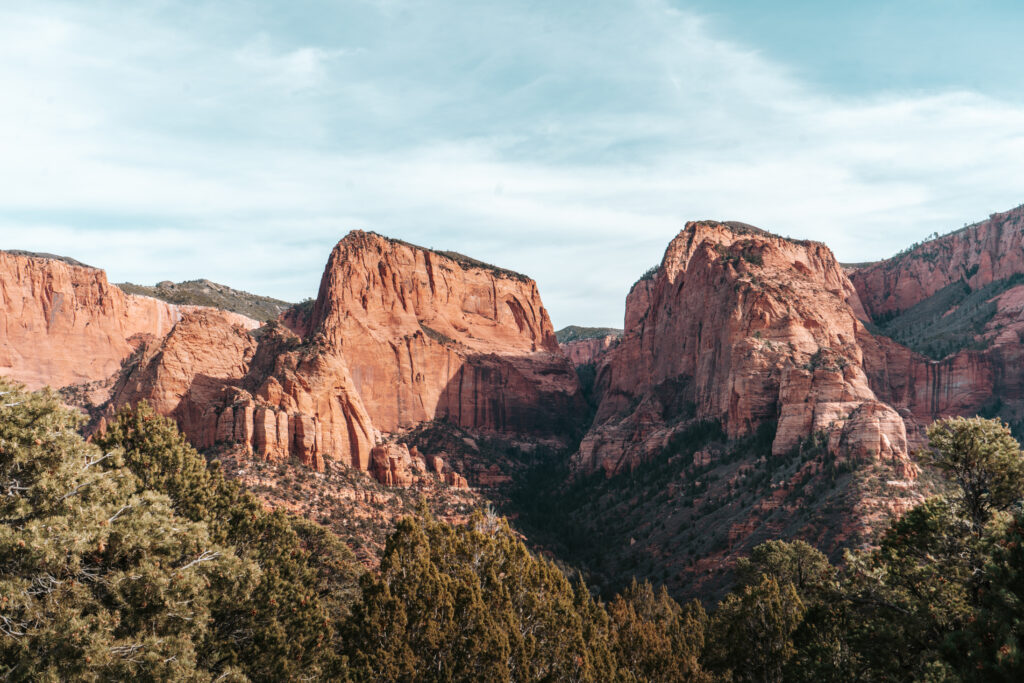
Should you do Angel’s Landing and the Narrows on your first visit?
Embarking on iconic hikes like Angels Landing and The Narrows in Zion National Park requires careful planning, especially for first-time visitors.
Angels Landing
This renowned trail is celebrated for its breathtaking views and challenging terrain. The hike spans approximately 5.4 miles (8.7 km) round-trip, with an elevation gain of about 1,488 feet (453 meters). The final half-mile involves traversing a narrow ridge with significant drop-offs, aided by chains for support. Due to safety concerns and to manage crowding, a permit system was introduced in 2022. Prospective hikers must secure a permit through a lottery system, either via a seasonal lottery held quarterly or a day-before lottery. Detailed information on the permit process is available on the National Park Service’s official website.
It’s important to note that since 1930, the majority of deadly accidents have taken place on the section of trail with the chains. Therefore, it’s crucial to use caution on the Angels Landing chains. Do not leave the path, as it is easy to get hurt if you are irresponsible.
Given the hike’s exposure and physical demands, it’s essential to assess your comfort with heights and physical readiness before attempting. As someone who opted out due to apprehension about the heights, I recommend that others consider their own comfort levels and preparedness before deciding to undertake this hike.
Read More // If like me you prefer you are not sure about this one, read this blog post about some amazing hikes to do instead of Angel’s Landing.
The Narrows
This unique hike involves trekking through the Virgin River, surrounded by towering canyon walls. The bottom-up hike from the Temple of Sinawava is approximately 9 miles (14.5 km) round-trip to Big Springs, though many choose to turn around earlier. Unlike Angels Landing, no permit is required for the bottom-up hike; however, a top-down hike does require a permit. Given the river’s integral role in the hike, water levels and weather conditions are critical factors. During my December visit, unfavorable conditions deterred me from attempting The Narrows. For those considering a winter hike, renting appropriate gear such as dry suits from local outfitters is advisable. Always check current conditions and potential flash flood risks before setting out.
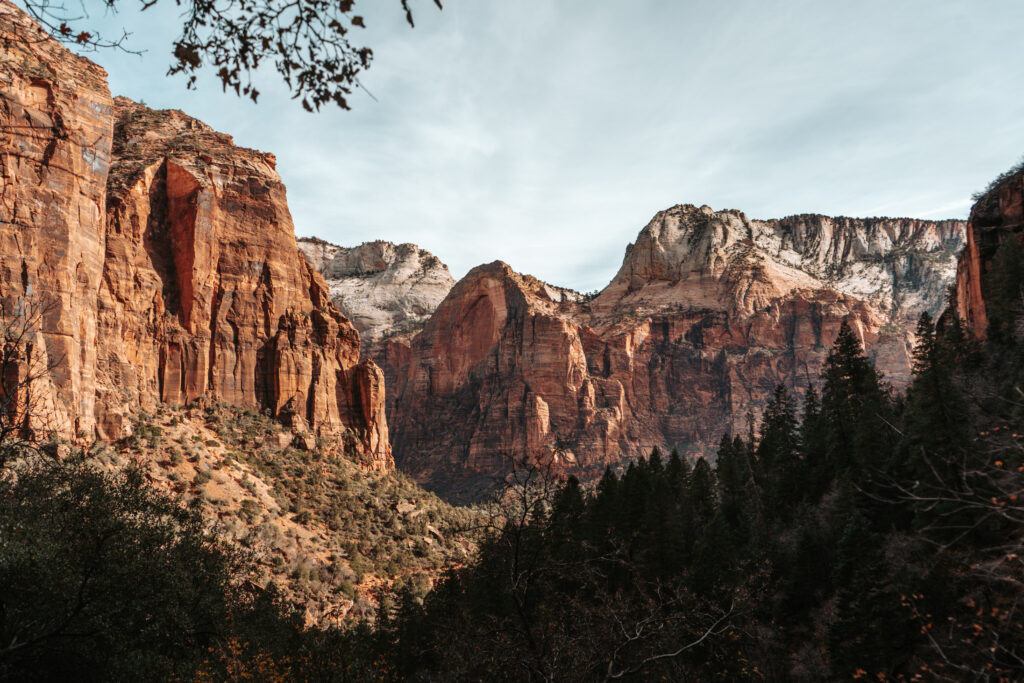
Zion National Park Guide: Important tips for First-Time Visitors
Read More // Visit a ghost town near Zion National Park. Read everything you need to know about Grafton Ghost Town here.
Plan Ahead and Arrive Early: Zion is among the most visited national parks in the U.S., attracting millions of visitors annually. To avoid large crowds and secure parking, especially during peak seasons, aim to arrive early in the morning. This strategy also allows you to enjoy cooler temperatures during warmer months.
Utilize the Shuttle System: From spring through fall, Zion operates a shuttle system to reduce traffic within the park. Familiarize yourself with shuttle routes and schedules to efficiently access trailheads and points of interest.
Choose the Right Time to Visit: Each season in Zion offers unique experiences. Spring and fall provide milder temperatures and vibrant scenery, while summer brings higher temperatures and larger crowds. Winter offers solitude but may come with trail closures due to snow. Consider your activity preferences when selecting your visit time.
Stay on Designated Trails: To protect the park’s delicate ecosystem and ensure your safety, always stay on marked trails. Venturing off-trail can cause environmental damage and may lead to hazardous situations.
Prepare for Weather Conditions: Zion’s weather can be unpredictable. Check forecasts before your trip and dress in layers to accommodate temperature fluctuations. Always carry rain gear and be aware of flash flood risks, especially if planning to hike The Narrows.
Stay Hydrated and Bring Snacks : The dry desert environment can lead to dehydration. Carry ample water and high-energy snacks to maintain your energy levels during hikes. Water sources are limited on trails, so plan accordingly.
Respect Wildlife: Observe animals from a distance and never feed them. Human food can harm wildlife, and close interactions can be dangerous for both visitors and animals.
Secure Necessary Permits: Some hikes, like Angels Landing, require permits due to their popularity and safety concerns. Research and obtain any necessary permits in advance to avoid disappointment.
Be Prepared for Limited Services : Cell service is limited within the park. Download maps and essential information beforehand, and inform someone about your itinerary, especially if venturing into less-traveled areas.
How much does it cost to visit Zion National Park?
Zion National Park has an entrance fee, which is fairly standard for national parks in the U.S. As of now, the cost to enter Zion is:
- Vehicle Fee: $35 for a 7-day pass, covering all occupants of a single, non-commercial vehicle.
- Motorcycle Fee: $30 for a 7-day pass, valid for one motorcycle and its riders.
- Individual Fee: $20 per person for a 7-day pass.
During our visit, we opted for the America the Beautiful Annual Pass. At $80, it gives you access to over 2,000 federal recreation sites, including Zion, for an entire year. If you plan on visiting three or more national parks, this is the best option. It’s a great way to save if you’re doing multiple park visits, as it covers the entrance fees at any participating national park and other federal lands.
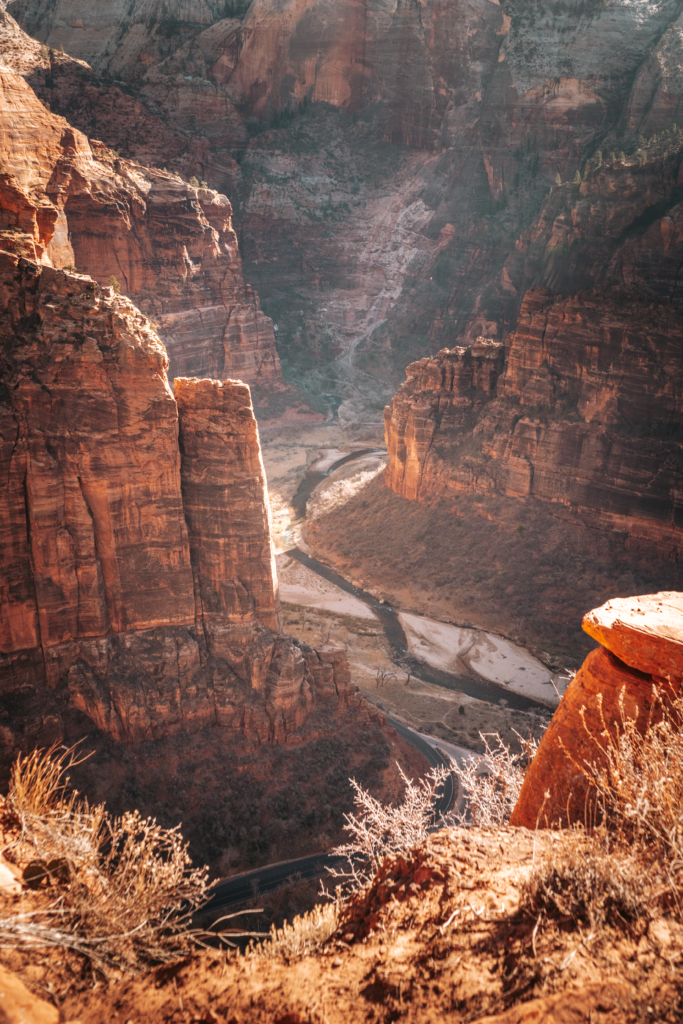
PIN THIS FOR LATER
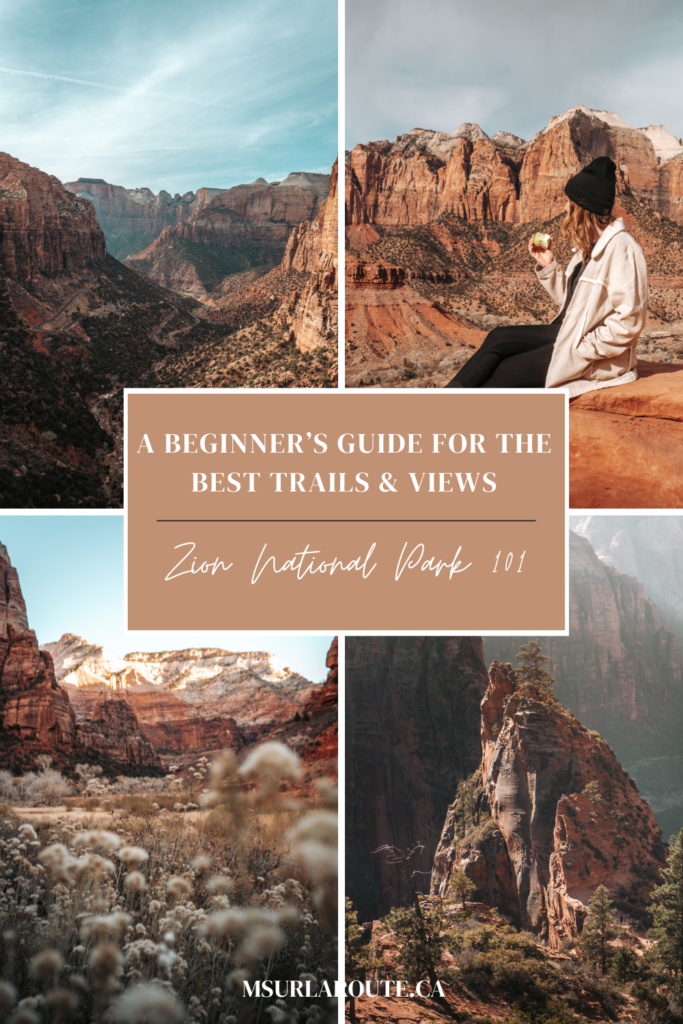
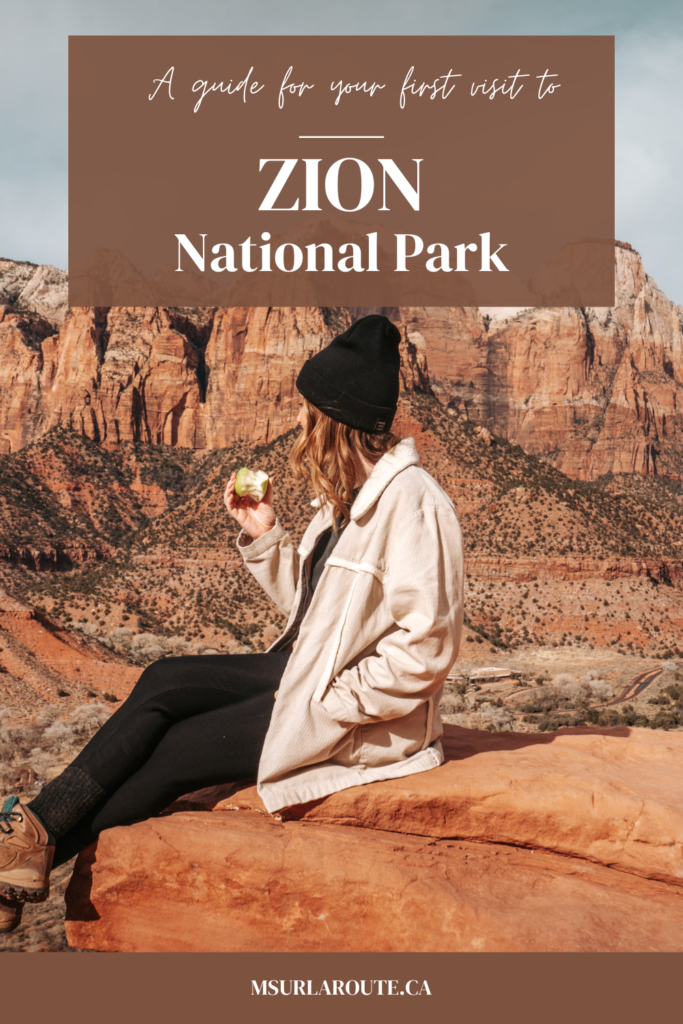
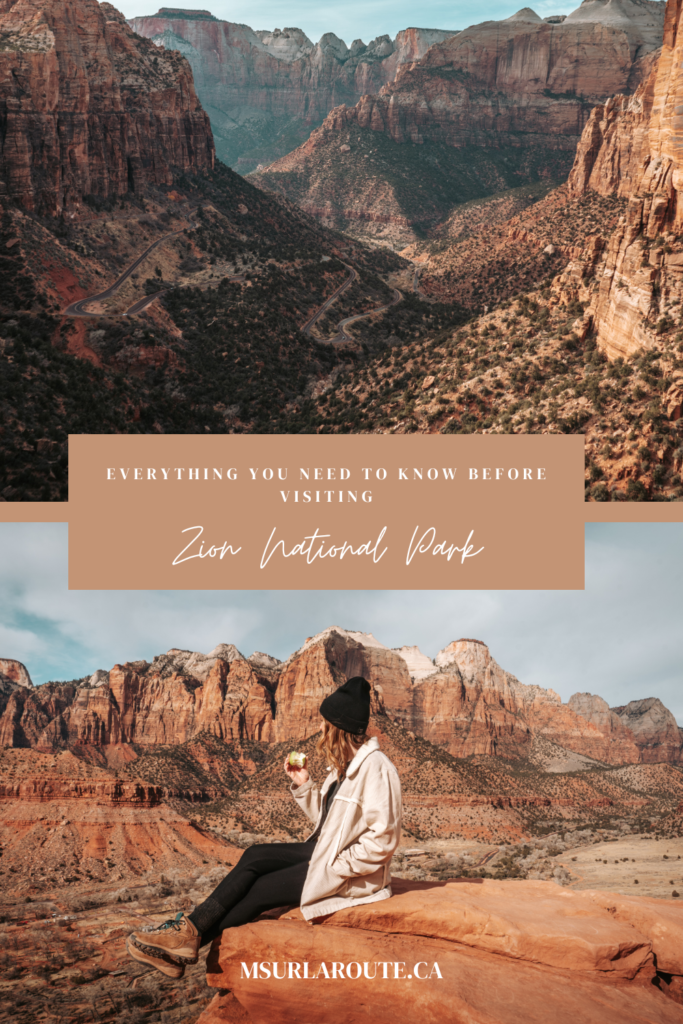
Follow me on Instagram!
✨ These trendy Ontario motels aren’t just Insta-famous, they actually live up to the hype.
From wine country escapes to lakeside slowdowns, here are 5 design-forward places to stay in Ontario that deliver on vibes and comfort:
🏩 The June Motel – Prince Edward County
The OG! Think wine country views, pink doors, and retro summer energy in PEC.
🌲 Somewhere Inn – Calabogie
A minimalist dream tucked between the mountains and the lake. Perfect for après-hike wine and no-alarm mornings.
🌊 The June Motel – Sauble Beach
Beachy, breezy, and very nostalgic in the best way. Just steps from Lake Huron.
🌾 The Beach Motel – Southampton
Light, airy, and super stylish. A grown-up coastal escape without the fuss.
🍂 The June Motel – Beaver Valley
The latest June gem, nestled in the hills. Fireplaces, forest views, and coffee ready on check-in.
✨ Save this post for your next Ontario getaway and tag someone you’d road trip with. Which one are you booking first?
🇫🇷 La version française est dans les commentaires!
#OntarioMotels #PlacesToStayInOntario #WeekendGetawayOntario #TrendyMotels #ExploreOntario

🌊 Think Niagara Falls is just about the Falls? Not even close. 👇
Here are 3 unforgettable things to do in Niagara Falls, Ontario — beyond the big cascade:
1️⃣ White Water Walk — Walk right alongside the world’s wildest whitewater rapids. Nature is LOUD here 🌊
2️⃣ Whirlpool Aero Car — Soar high above the Niagara Gorge for panoramic views you won’t forget 🚡
3️⃣ Niagara Glen Nature Centre — Hike through ancient trails and discover a quieter side of Niagara 🌿
Planning a trip to Niagara Falls? Save this post, tag your travel buddy, and let me know which one you’re doing first 👇
🇫🇷 La version française de ce texte se trouve dans les commentaires.
#NiagaraFalls #NiagaraFallsCanada #ExploreOntario #OntarioTravel #discoverontario

I knew Tuscany would be beautiful… but I didn’t expect to feel so enchanted by its smaller towns.
Here are four stops that completely stole the show on my trip:
1. San Gimignano
Known as the Manhattan of the Middle Ages (because of its towers), this hilltop town has views for days and some of the best gelato I’ve ever had. It’s busy, yes, but worth every step. Go early or stay late to see it glow in the golden hour.
2. Monteriggioni
This one feels like a secret. A perfectly preserved medieval village perched on a hill, surrounded by ancient stone walls. You can walk the ramparts, sip wine in the tiny square, and imagine what life looked like hundreds of years ago.
3. Siena
Florence’s historical rival, and a city with serious soul. The Piazza del Campo is stunning, but it’s the backstreets that really charmed me. Don’t skip the Duomo, it’s easily one of the most incredible churches I’ve ever seen.
4. Lucca
Soft light, quiet charm, and tree-lined walls you can walk or bike on. Lucca doesn’t try too hard, and that’s what makes it special. It’s a town for slow mornings and long lunches.
Swipe through to see a little glimpse of each.
And if you’ve ever been, tell me: which one stole your heart? ❤️
🇫🇷 La version française de ce texte se trouve dans les commentaires.
#TuscanyTowns #TuscanyTravel #ItalyItinerary #SanGimignano #Monteriggioni #SienaItaly #LuccaTuscany #SlowTravel #ItalianEscape

7 ways to make your summer in the Thousand Islands not boring 🛶🍻🍎⛺️
If you’ve only driven past Gananoque on the 401… you’ve been seriously missing out. This region along the St. Lawrence River is packed with scenic views, cider tastings, and unforgettable outdoor adventures.
Here’s your non-boring summer to-do list in the 1000 Islands, Ontario:
1️⃣ Hike up to Landon Bay Lookout for one of the best views in the region
2️⃣ Sip local cider at the beautiful @buslcider
3️⃣ Climb the 1000 Islands Tower for a panoramic view of the islands
4️⃣ Try beer and wood-fired pizza at @arbrubeer
5️⃣ Paddle your way through the islands on a guided kayak tour
6️⃣ Take a scenic helicopter ride over the Thousand Islands 🚁
7️⃣ Spend the night in a Parks Canada O’Tentik tent, part cabin, part tent, fully cozy
This is your sign to explore the Thousand Islands this summer and turn a day trip into a full weekend escape.
Which one are you adding to your bucket list?👇
🇫🇷 La version française de ce texte se trouve dans les commentaires.
#ThousandIslands #1000IslandsOntario #ExploreOntario #SummerInOntario #Gananoque #OntarioWeekendTrip #OntarioTravel #StLawrenceRiver #OutdoorAdventure #TravelOntario #ThingsToDoInOntario #OntarioGetaways

Sippin’ my way through Prince Edward County like it’s a full-time job 🍷🍸🍺
If you’re the type who plans your Ontario summer trip around what you can drink as much as what you can do… this one’s for you.
From award-winning wineries to farm-based distilleries and lakeside cideries, here’s your ultimate guide to raising a glass (or three) in Prince Edward County this summer:
📍 Bare Bones for small-batch gin
🍷 Karlo Estates for award winning wines in a charming barn
🥂 Hinterland for bubbles with a view
🍎 County Cider for that perfect patio moment
🍷 The Grange for elegant sips in a heritage setting
🍸 Wild Lot for cocktails in the middle of the countryside
🍺 Parson’s Brewing for chill vibes & beer flights
🍷 Closson Chase for iconic lavender-lined photos & Pinot
🍺 Slake Brewery for that sunset magic
🍸 BONUS: The Russ & Co for an elevated cocktail hour in downtown Picton
This is your summer drink-lover guide to Prince Edward County, Ontario — whether you’re into wine tasting, craft beer, or creative cocktails, there’s a pour waiting for you.
Tag your drinking buddy & start planning your County crawl 🥂

